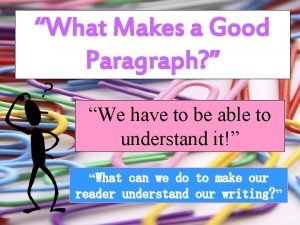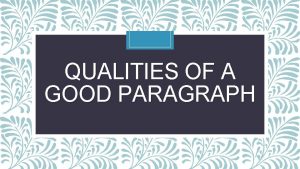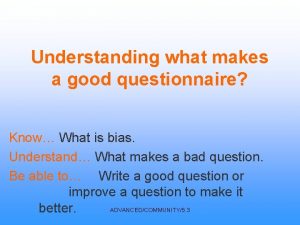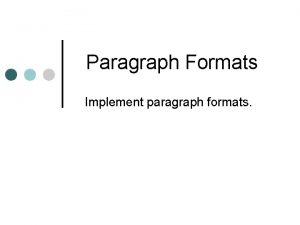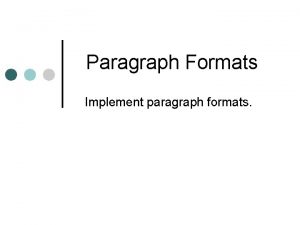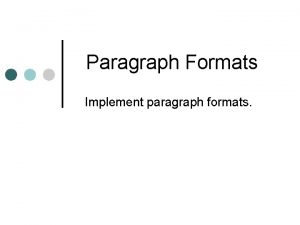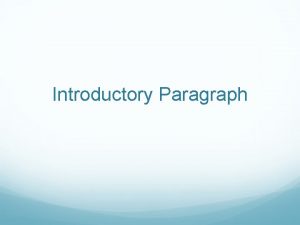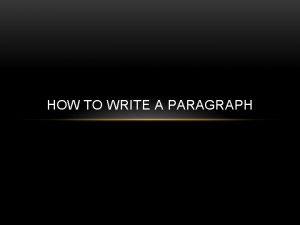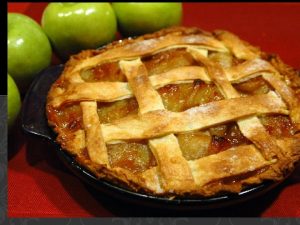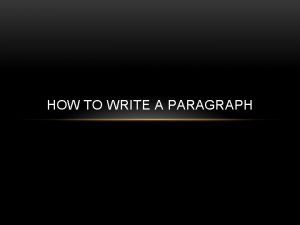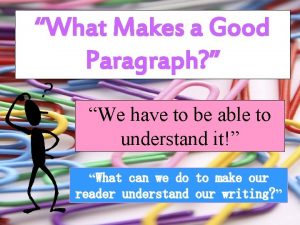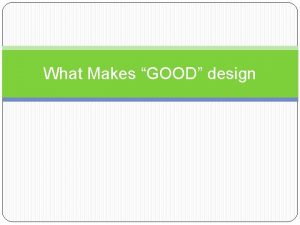What Makes a Good Paragraph We have to











- Slides: 11

“What Makes a Good Paragraph? ” “We have to be able to understand it!” “What can we do to make our reader understand our writing? ”

3 Things Make a Good Paragraph: 1. Unity 2. Coherence 3. Elaboration “What do all of these

Let’s Start with Unity… “What does unity mean to you? ” • When a paragraph has unity, all the sentences relate directly to the main idea. Use only the most important details! • If there is a sentence off topic at all, this begins to create confusion for your reader.

LET’S SEE AN EXAMPLE… Find the sentence in the paragraph that destroys the unity and doesn’t belong. The disappearance of Amealia Earhart remains a mystery. Earhart, who was the first woman pilot to fly across the Atlantic Ocean, crashed into the Pacific Ocean while attempting to fly around the world. She was born in Atchison, Kansas, in 1897. Some researchers believe that she survived the crash into the Pacific, because radio distress calls were received. An intensive search for the source of the signals was made. Searchers were not able to find her, however. Finally, the distress signals ceased. In spite of continued searches by airplane and ship, no clue about what became of Amelia Earhart has yet been found. She was born in Atchison, Kansas in 1897. = Doesn’t relate directly to main idea.

#2: COHERENCE • A coherent paragraph is one in which all of the sentences logically fit together. • When a paragraph has coherence, your reader can easily see how all of the details are connected.

“How can we create coherence? ” There are 2 ways! 1. Order details in a way that makes sense. 2. Show a connection by using transitional words.

“Order Please!” Not that kind of order! Coherence Organizing your details in a specific order is one way to make your paragraph clear and coherent. Chronological Order Presents details in the order they occur Spatial Order Presents details according to location Order of Importance Details are least important to most or the reverse Logical Order Groups related details together “Look at the chart!” Coherence

Another Way to Create Coherence: Transitional Words “We want to see a connection!” Transitional words help the reader see a relationship between ideas. after later next across around beyond inside because soon meanwhile first before then They tie things together! under down therefore finally consequently

# 3: Elaboration “Give us more detail! Elaboration means: to add more detail, so your reader can get a clear picture of what you mean!

Here are Nine Ways to Elaborate! 1. Use Highly Descriptive Words: vivid adj. ’s & adv. ’s, precise V’s & N’s. 2. Give a detailed Definition of the subject or detail. 3. Provide an Example that shows your point. 4. Use Comparison: Similes and/or Metaphors. 5. Use Contrast to show your idea is different from something else. 6. Include a Fact to support your main idea. 7. Use a Statistic (a fact in numerical form) to support your main idea. 8. Use Sensory Details that appeals to one or more of the 5 senses. 9. Use Cause & Effect to explain how 1 thing causes another.

“Now we see what you’re talking about!”
 What makes a good paragraph
What makes a good paragraph Good deeds good words good thoughts
Good deeds good words good thoughts B. good afternoon
B. good afternoon Cómo se dice buenas tardes
Cómo se dice buenas tardes You are good you are good when there's nothing good in me
You are good you are good when there's nothing good in me Good afternoon morning
Good afternoon morning Lets be good friends
Lets be good friends What are the qualities of a paragraph
What are the qualities of a paragraph This has 6 faces 12 edges and 8 vertices
This has 6 faces 12 edges and 8 vertices Setting of cinderella story
Setting of cinderella story What makes a good theory
What makes a good theory What makes a good questionnaire
What makes a good questionnaire
